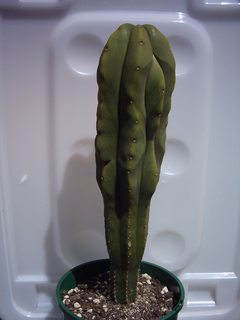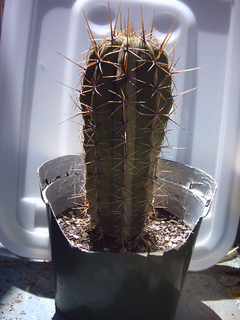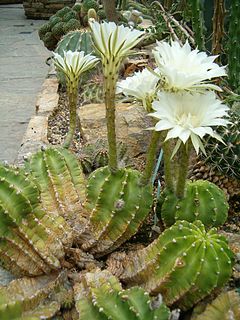
A cactus is a member of the plant family Cactaceae, a family comprising about 127 genera with some 1750 known species of the order Caryophyllales. The word cactus derives, through Latin, from the Ancient Greek word κάκτος (káktos), a name originally used by Theophrastus for a spiny plant whose identity is now not certain. Cacti occur in a wide range of shapes and sizes. Although some species live in quite humid environments, most cacti live in habitats subject to at least some drought. Many live in extremely dry environments, even being found in the Atacama Desert, one of the driest places on Earth. Because of this, cacti show many adaptations to conserve water. For example, almost all cacti are succulents, meaning they have thickened, fleshy parts adapted to store water. Unlike many other succulents, the stem is the only part of most cacti where this vital process takes place. Most species of cacti have lost true leaves, retaining only spines, which are highly modified leaves. As well as defending against herbivores, spines help prevent water loss by reducing air flow close to the cactus and providing some shade. In the absence of true leaves, cacti's enlarged stems carry out photosynthesis. Cacti are native to the Americas, ranging from Patagonia in the south to parts of western Canada in the north—except for Rhipsalis baccifera, which also grows in Africa and Sri Lanka.

Echinopsis is a large genus of cacti native to South America, sometimes known as hedgehog cactus, sea-urchin cactus or Easter lily cactus. One small species, E. chamaecereus, is known as the peanut cactus. The 128 species range from large and treelike types to small globose cacti. The name derives from echinos hedgehog or sea urchin, and opsis appearance, a reference to these plants' dense coverings of spines.

Pachycereus pringlei, also known as Mexican giant cardon or elephant cactus, is a species of cactus native to northwestern Mexico in the states of Baja California, Baja California Sur, and Sonora. It is commonly known as cardón, a name derived from the Spanish word cardo, meaning "thistle".

Echinopsis peruviana, the Peruvian torch cactus, is a fast-growing columnar cactus native to the western slope of the Andes in Peru, between about 2,000–3,000 m (6,600–9,800 ft) above sea level.

Echinopsis lageniformis, the Bolivian torch cactus, is a fast-growing columnar cactus from the high deserts of Bolivia. Among the indigenous populations of Bolivia, it is sometimes called achuma or wachuma, although these names are also applied to related species such as Echinopsis pachanoi which are also used for their psychedelic effects.

Echinopsis scopulicola is a type of cactus native to Bolivia, which contains psychedelic compounds. Many claimed this species contained mescaline. This was confirmed in 2010 in a study of well-documented individual living plants of the subgenus Trichocereus of the genus Echinopsis. E. scopulicola was noted to contain 0.82% mescaline by dry weight in the outer green layer.

Echinopsis spachiana, commonly known as the golden torch, (white) torch cactus or golden column, is a species of cactus native to South America. Previously known as Trichocereus spachianus for many years, it is commonly cultivated as a pot or rockery plant worldwide. It has a columnar habit, with a lime-green cylindrical body with 1–2 cm long golden spines.

Echinopsis macrogona, syn. Trichocereus macrogonus, is a species of cactus found in Bolivia.

Echinopsis pachanoi —known as San Pedro cactus—is a fast-growing columnar cactus native to the Andes Mountains at 2,000–3,000 m (6,600–9,800 ft) in altitude. It is found in Argentina, Bolivia, Colombia, Chile, Ecuador and Peru, and it is cultivated in other parts of the world. Uses for it include traditional medicine and traditional veterinary medicine, and it is widely grown as an ornamental cactus. It has been used for healing and religious divination in the Andes Mountains region for over 3,000 years. It is sometimes confused with its close relative Echinopsis peruviana.

The saguaro is a tree-like cactus species in the monotypic genus Carnegiea that can grow to be over 12 meters tall. It is native to the Sonoran Desert in Arizona, the Mexican state of Sonora, and the Whipple Mountains and Imperial County areas of California. The saguaro blossom is the state wildflower of Arizona. Its scientific name is given in honor of Andrew Carnegie. In 1994, Saguaro National Park, near Tucson, Arizona, was designated to help protect this species and its habitat.

Echinopsis schickendantzii is a cactus found in Northwestern Argentina in provinces of Salta and Tucumán at elevations of 1600 to 3200 meters.

Neobuxbaumia polylopha is found only in Mexico and is confined to a small area in the state of Guanajuato. It grows only in canyons with limestone slopes, similar to the cacti Neobuxbaumia multiareolata, Neobuxbaumia sanchezmejunadae, and Neobuxbaumia squamulosa. Neobuxbaumia polylopha is not well known among locals and has no local uses. However, it is popular among cactus enthusiasts and reproduces well in nurseries.

Echinopsis chiloensis is a species of cactus native to South America; genus members are known as hedgehog cacti, sea-urchin cactus or Easter lily cactus.
Many cacti are known to be psychoactive, containing phenethylamine alkaloids such as mescaline. However, the two main ritualistic (folkloric) genera are Echinopsis, of which the most psychoactive species is the San Pedro cactus, and Lophophora, with peyote being the most psychoactive species. Several other species pertaining to other genera are also psychoactive, though not always used with a ritualistic intent.

Echinopsis chamaecereus is a species of cactus from Argentina. Synonyms include Chamaecereus silvestrii and Lobivia silvestrii. It has been called the "peanut cactus", This plant should not be confused with Echinopsis silvestrii, another species with a very different appearance.

Echinopsis mamillosa is a species of cactus from Bolivia.

Echinopsis candicans is a species of cactus from northern and western Argentina. It has large fragrant white flowers that open at night.

Echinopsis atacamensis (cardón) is a species of cactus from Chile, Argentina and Bolivia. The wood of this species can be used in building and in making furniture.

Echinopsis eyriesii is a species of cacti of the genus Echinopsis.

Cereus spegazzinii is a species of cactus found in Argentina, Bolivia, Brasil and Paraguay.
























